

12 Must-Read Articles About Assessment - The Importance of Assessment AS Learning. Lately, I have been focusing on “common assessments” versus “common understandings.”

I have written about this in the past and shared the following ideas on why “common assessments” do not necessarily do what they hope they do.” So here is where I struggle with this concept of “common assessments”. If teacher A does not work with classroom B, do they know the students in that room? Do they know that some of the students have test anxiety, or English is not their first language, or are a myriad of other factors that might not be conducive to “common assessments”? Now there is a difference between wanting students to have the same test, or the same understandings of material. Socrative. 21 Tools for Conducting Digital Formative Assessments - Best of 2017. As I do during this week every year, I am taking some time off to relax and prepare for the new year.
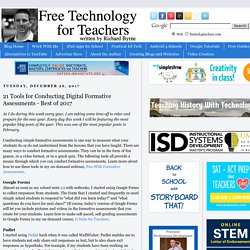
Every day this week I will be featuring the most popular blog posts of the year. This was one of the most popular posts in February. Conducting simple formative assessments is one way to measure what your students do or do not understand from the lessons that you have taught. There are many ways to conduct formative assessments. Take Three! 55 Digital Tools and Apps for Formative Assessment Success.
There is no shortage of strategies, techniques, and tools available to teachers who use formative assessment in their classrooms.
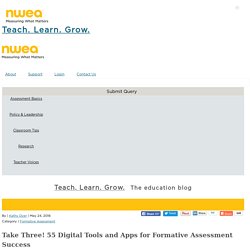
It’s been over a year since we published our blog on digital tools and apps for formative assessment success and some of them we listed are no longer around. The good news is that there are new tools and apps that are available today that can help facilitate evidence of student learning. Here is an updated version of our list of digital tools and apps for formative assessment success. Share your tools, ideas, and thoughts with us so we can continue to keep this list growing and current.
Dotstorming. Welcome! Know Students Better: A Visual Guide to Formative Assessment Tools. When teachers know their students well, they can build strong connections that lead to better learning.
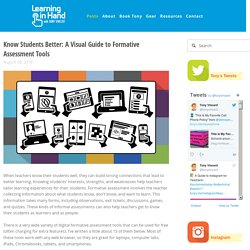
Knowing students’ interests, strengths, and weaknesses help teachers tailor learning experiences for their students. Formative assessment involves the teacher collecting information about what students know, don’t know, and want to learn. This information takes many forms, including observations, exit tickets, discussions, games, and quizzes. These kinds of informal assessments can also help teachers get to know their students as learners and as people. Spider Web Discussions as a Formative Assessment. Several years ago, I began implementing more classroom opportunities for my students to practice their verbal communication skills.
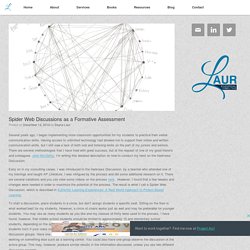
Having access to unlimited technology had allowed me to support their online and written communication skills, but I still saw a lack of both oral and listening skills on the part of my juniors and seniors. There are several methodologies that I have tried with great success, but at the request of one of my good friend’s and colleagues, John McCarthy, I’m writing this detailed description on how to conduct my twist on the Harkness Discussion. Early on in my consulting career, I was introduced to the Harkness Discussion, by a teacher who attended one of my trainings and taught AP Literature. I was intrigued by the process and did some additional research on it. There are several variations and you can view some videos on the process here. To start a discussion, place students in a circle, but don’t assign students a specific seat.
A List of Formative Assessment Tools That Are Fast and Fun. Trying to find the right in-class formative assessment tools doesn’t need to be hard.
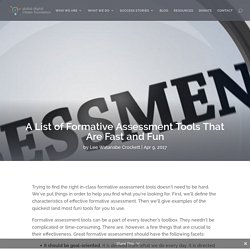
We’ve put things in order to help you find what you’re looking for. First, we’ll define the characteristics of effective formative assessment. Then we’ll give examples of the quickest (and most fun) tools for you to use. Formative assessment tools can be a part of every teacher’s toolbox. They needn’t be complicated or time-consuming. It should be goal-oriented. Create Interactive Diagram Quizzes in Formative. Creating a diagram-based quiz or quiz question is something that you could find yourself doing in almost every content area.
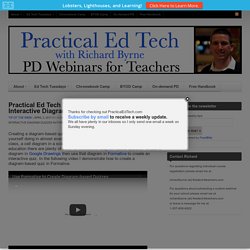
Whether it’s a timeline in a history class, a cell diagram in a science class, or a playing field illustration in physical education there are plenty of uses for interactive diagram-based quizzes. Educational Leadership:Using Assessments Thoughtfully:The Right Questions, The Right Way. Lessons From Nature. SPOTLIGHT ON ASSESSMENT. Peer assessment means that students assess each other.
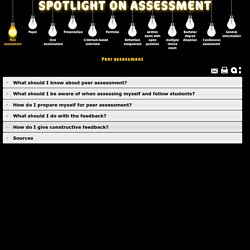
You give your fellow students feedback about a product, a service or a process. This involves allocating marks or giving open feedback based on pre-determined criteria. Example of possible assessment criteria: taking initiative, being well prepared, engaging in a constructive search for solutions to problems, etc. Assessment: attitudes, practices and needs. 21 Tools for Conducting Digital Formative Assessments. Conducting simple formative assessments is one way to measure what your students do or do not understand from the lessons that you have taught.

There are many ways to conduct formative assessments. They can be in the form of fun games, in a video format, or in a quick quiz. The following tools all provide a means through which you can conduct formative assessments.Google Forms Almost as soon as my school went 1:1 with netbooks, I started using Google Forms to collect responses from students. The Form that I created and frequently re-used simply asked students to respond to "what did you learn today? " and "what questions do you have for next class?
" Padlet I started using Padlet back when it was called WallWisher. Formative Assessment with Hexagonal Learning. Even though I’ve already mentioned Hexagonal Learning a couple of other times on this blog, it definitely bears repeating.

If you want to listen to your students having rich conversations about a topic and to discover how well they understand something they have read or that you have taught, this activity will deliver. And, although I can’t make any guarantees, I have always seen complete engagement with Hexagonal Learning – even from introverts and students who have attention difficulties. You can find details in last year’s post (linked above). I just completed another round of Hexagonal Learning for Tuck Everlasting with a new class, and was once again blown away by the intensity of the discussions and deliberate care that went into each group’s connections. My 5th graders, who were last year’s Tuck Everlasting class, also just completed the same assignment with hexagons from The Giver.
Knowlounge. Spiral - Free collaborative apps for 1:1 classrooms. First-Class Formative Assessment Tips for Every Teaching Toolkit. 15 Assessment Activities That Are Fast, Fun, and Formative. Assessment activities should be quick, enjoyable, and versatile. That’s because formative assessment is best when it’s ongoing and consistent. Teachers use it in their classrooms to provide critical feedback to students. It helps them to monitor and modify their instruction methods and lesson plans to improve learning outcomes. How do I use the Korthagen reflection circle diagram? The Korthagen methodology (2002) is mainly used to examine how you operate in your professional life.
Sources: Korthagen, F.A.J. & Vasalos, A. (2002). Niveaus in reflectie: naar maatwerk in begeleiding. VELON-Tijdschrift voor lerarenopleiders, 23(1), p. 29-38. Creating alternative methods of action Trial and Action Action/Experience Looking back Awareness of essential aspects Phase 1: Describe the experience/situation you wish to reflect upon. Welcome to Flubaroo. Formative. Resources for Assessment in Project-Based Learning. Project-based learning (PBL) demands excellent assessment practices to ensure that all learners are supported in the learning process.
With good assessment practices, PBL can create a culture of excellence for all students and ensure deeper learning for all. We’ve compiled some of the best resources from Edutopia and the web to support your use of assessment in PBL, including information about strategies, advice on how to address the demands of standardized tests, and summaries of the research.
PBL Assessment Foundations 10 Tips for Assessing Project-Based Learning (Edutopia, 2011) This comprehensive guide from Edutopia goes over many best practices for assessment, including authentic products, good feedback, formative assessment, and digital tools. Coopevalpacket. CO LAB Guidelines for Assessing Collaboration. RubiStar Home. 34 Strategies For The Stages Of Assessment: Before, During & After - 34 Strategies For The Stages Of Assessment: Before, During & After by TeachThought Staff For professional development on assessment, contact us today. The follow graphic from the infographic-famous Mia MacMeekin offers 34 strategies for each stage of the assessment process–before, during, and after. Rather than simply repeat them from the graphic, we’ve give a quick primer on the differences between each stage in terms of its purpose/function in the learning process.
Take to the comments with any strategies you find useful in your classroom, and give Mia a follow on twitter and say hello! Assessment and Rubrics.